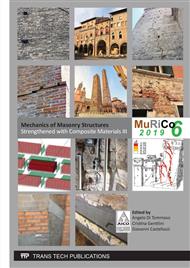[1]
D'Antino, T. and Papanicolaou, C. (2017). Mechanical characterization of textile reinforced inorganic-matrix composites. Composites Part B: Engineering, 127, 78-91.
DOI: 10.1016/j.compositesb.2017.02.034
Google Scholar
[2]
Donnini, J. and Corinaldesi, V. (2017). Mechanical characterization of different FRCM systems for structural reinforcement. Construction and Building Materials, 145, 565-575.
DOI: 10.1016/j.conbuildmat.2017.04.051
Google Scholar
[3]
Dalalbashi, A., Ghiassi, B., Oliveira, D. V., Freitas, A. (2018a). Fiber-tomortar bond behavior in TRM composites: effect of embedded length and fiber configuration. Composites Part B: Engineering.
DOI: 10.1016/j.compositesb.2018.06.014
Google Scholar
[4]
Bellini, A., Bovo, M., Mazzotti, C. (2019). Experimental and numerical evaluation of fiber-matrix interface behavior of different FRCM systems. Composites Part B: Engineering, 161, 411-426.
DOI: 10.1016/j.compositesb.2018.12.115
Google Scholar
[5]
Leone, M., Aiello, M. A., Balsamo, A., Carozzi, F. G., Ceroni, F., Corradi, M., ... Mazzotti, C. (2017). Glass fabric reinforced cementitious matrix: Tensile properties and bond performance on masonry substrate. Composites Part B: Engineering, 127, 196-214.
DOI: 10.1016/j.compositesb.2017.06.028
Google Scholar
[6]
Carozzi, F. G., Bellini, A., D'Antino, T., de Felice, G., Focacci, F., Hojdys, Ł., ... & Poggi, C. (2017). Experimental investigation of tensile and bond properties of Carbon-FRCM composites for strengthening masonry elements. Composites Part B: Engineering, 128, 100-119.
DOI: 10.1016/j.compositesb.2017.06.018
Google Scholar
[7]
Ombres, L., Mancuso, N., Mazzuca, S., Verre, S. (2018b). Bond between Carbon Fabric-Reinforced Cementitious Matrix and Masonry Substrate. Journal of Materials in Civil Engineering, 31(1), 04018356.
DOI: 10.1061/(asce)mt.1943-5533.0002561
Google Scholar
[8]
Caggegi, C., Carozzi, F. G., De Santis, S., Fabbrocino, F., Focacci, F., Hojdys, Ł., ... & Zuccarino, L. (2017). Experimental analysis on tensile and bond properties of PBO and aramid fabric reinforced cementitious matrix for strengthening masonry structures. Composites Part B: Engineering, 127, 175- 195.
DOI: 10.1016/j.compositesb.2017.05.048
Google Scholar
[9]
De Santis, S., Ceroni, F., de Felice, G., Fagone, M., Ghiassi, B., Kwiecień, A., ... & Viskovic, A. (2017). Round Robin Test on tensile and bond behavior of Steel Reinforced Grout systems. Composites Part B: Engineering, 127, 100-120.
DOI: 10.1016/j.compositesb.2017.03.052
Google Scholar
[10]
Bilotta, A., Ceroni, F., Lignola, G. P., Prota, A. (2017). Use of DIC technique for investigating the behavior of FRCM materials for strengthening masonry elements. Composites Part B: Engineering, 129, 251-270.
DOI: 10.1016/j.compositesb.2017.05.075
Google Scholar
[11]
Tekieli, M., De Santis, S., de Felice, G., Kwiecień, A., Roscini, F. (2017). Application of Digital Image Correlation to composite reinforcements testing. Composite Structures, 160, 670-688.
DOI: 10.1016/j.compstruct.2016.10.096
Google Scholar
[12]
Caggegi, C., Lanoye, E., Djama, K., Bassil, A., & Gabor, A. (2017). Tensile behavior of a basalt TRM strengthening system: influence of mortar and reinforcing textile ratios. Composites Part B: Engineering, 130, 90-102.
DOI: 10.1016/j.compositesb.2017.07.027
Google Scholar
[13]
ICC. AC434. (2013). Proposed Acceptance Criteria for Masonry and Concrete Strengthening Using Fibre-reinforced Cementitious Matrix (FRCM) Composite Systems,. Whittier, CA: ICC-Evaluation Service.
DOI: 10.14359/51702356
Google Scholar
[14]
RILEM Technical Committee 232-TDT (Wolfgang Brameshuber) Mater Struct (2016) 49: 4923. doi:10. 1617/s115270160839z.
DOI: 10.1617/s11527-016-0839-z
Google Scholar
[15]
Linea Guida per la identificazione, la qualificazione ed il controllo di accettazione di compositi fibrorinforzati a matrice inorganica (FRCM) da utilizzarsi per il consolidamento strutturale di costruzioni esistenti,. (2019). Published by the Italian Ministry of Public Works.
DOI: 10.3221/igf-esis.12.04
Google Scholar
[16]
ISO 13934-1, (April 2013). Textiles – Tensile properties of fabrics – Part 1: Determination of maximum force and elongation at maximum force using the strip method,. CEN – European Committee for Standardization.
DOI: 10.3403/30254791
Google Scholar
[17]
EN 1015-11, (1999). Methods of test for mortar for masonry – Part 11: Determination of flexural and compressive strength of hardened mortar,.
DOI: 10.3403/01905442u
Google Scholar


